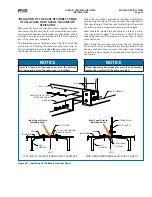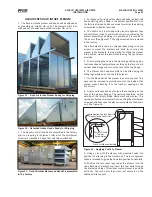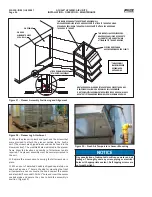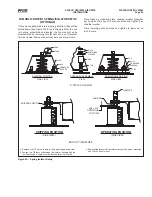
210.100-IOM (JUL 2018)
Page 10
ACUAIR
®
HYGIENIC AIR UNITS
INSTALLATION
Figure 5 – Lifting Lugs
WARNING
Do not lift non-base units or subassembly by attaching
clevis hooks, pins or bolts to casing, casing hardware,
angles, tabs or flanges.
LD07923A
HOUSING
BASE SKIN
LIFTING LUG
PERIMETER
CHANNEL
Do not lift non-base units or subassemblies by attaching clevis,
hooks, pins, bolts, etc. to casing, casing hardware, angles, tabs
or flanges.
See CAUTION
!
Lift the air unit only in an upright
position. Never lift or move a unit on its side or upside-down.
CAUTION
If you do not rig or lift the unit carefully, you could
damage the unit, hurt yourself or others. USE CAUTION!
SUPPORT STRUCTURE INFORMATION
AcuAir
®
systems may be shipped in two or more sections.
These sections must be anchored to a suitable support
structure - concrete pads, concrete piers, or structural steel,
capable of supporting the total system operating weight plus a
significant safety margin as determined by a qualified structural
engineer. The weight the support structure must support and
the anchoring requirements will vary with live loads (expected
snow/ice buildup) seismic, and wind loading. See Figures 6
and 7 for AcuAir unit support methods.
If the support structure is in the form of two or more parallel
steel beams, the beams should be sized in accordance with
standard engineering practices. The structure must be capable
of supporting the shipping weight of the unit as provided on
the order related document, plus any operating-duty-related
loads such as: water or refrigerant within the cooling and
heating coils; possible frost on the cooling coils; any applicable
flooded refrigerant surge vessel and associated piping; snow
loads that could accumulate on the roof; horizontal wind
loads; etc.
It is recommended that the structure be designed for at least
110% of the operating weight of the system distributed as
a uniform load over the longitudinal beams, allowing for a
maximum deflection of 1/360 of the length, not to exceed 1/2".
The support structure, whether concrete pads, concrete piers,
or structural steel, on which the units are to be located should
be rigid and level (shim if required).
Shims should be placed at intervals no greater than 5 feet apart
and should not be used to compensate for significant surface
slope. The sum total of any individual stack of shims should
not exceed ½” and are to be used to compensate for surface
irregularities only. On units more than 150 inches wide the
foundation shall support not only the perimeter base channel,
but also the midpoint of each unit split. (Reference Figure 6)
Consult factory if housekeeping pad is not continuous.
The AcuAir unit must be secured to the Support structure. It
is the installer’s responsibility to be sure the unit is secured
in accordance with applicable codes.
NOTICE
Shims may be used between the AcuAir unit and the
supporting structure. When shims are used they should
be spaced no more than 5 feet apart. Shim stacks should
not exceed 1/2 inch in height.
ASSEMBLY HINT
Units must typically be SLID into final position. Applying
grease to the support surface may make this easier.
NOTICE
Save bolts when removing lifting lugs. Bolts will be used
for assembly of split units.
Summary of Contents for AcuAir
Page 54: ......











































